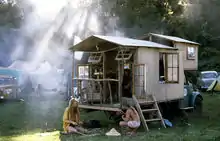An alternative lifestyle is a lifestyle perceived to be outside the norm for a given culture. The phrase "alternative lifestyle" is often used pejoratively.[1] Description of a related set of activities as alternative is a defining aspect of certain subcultures.[2]
History
Alternative lifestyles and subcultures were first highlighted in the U.S. in the 1920s with the "flapper" movement. Women cut their hair and skirts short (as a symbol of freedom from oppression and the old ways of living).[3] These women were the first large group of females to practice pre-marital sex, dancing, cursing, and driving in modern America without the ostracism that had occurred in earlier instances, such as the Church of Jesus Christ of Latter-day Saints.
The American press in the 1970s frequently used the term "alternative lifestyle" as a euphemism for homosexuality out of fear of offending a mass audience. The term was also used to refer to hippies, who were seen as a threat to the social order.[1]
Examples

The following is a non-exhaustive list of activities in the U.S. that have been described as alternative lifestyles:
- A Stanford University cooperative house, Synergy, was founded in 1972 with the theme of "exploring alternative lifestyles".[4]
- Alternative child-rearing, such as homeschooling, coparenting, and home births
- Environmentally-conscious ways of eating, such as veganism, freeganism, or raw foodism
- Living in non-traditional communities, such as communes, intentional communities, ecovillages, off-the-grid, or the tiny house movement
- Traveling subcultures, including lifestyle travellers, digital nomads, housetruckers, and New Age travellers
- Countercultural movements and alternative subcultures such as Bohemianism, punk rock, emo, metal music subculture, antiquarian steampunk, hippies, and vampires
- Body modification, including tattoos, body piercings, eye tattooing, scarification, non-surgical stretching like ears or genital stretching, and transdermal implants
- Nudism and clothing optional lifestyles
- Non-normative sexual lifestyles and gender identity-based subcultures, such as BDSM, LGBT culture, cross-dressing, transvestism, polyamory, cruising, swinging, down-low, and certain types of sexual fetishism, roleplays, or paraphilias[5]
- Adherents to alternative spiritual and religious communities, such as Freemasons, Ordo Templi Orientis, Thelemites, Satanists, Modern Pagans, and New Age communities
- Certain traditional religious minorities, such as Anabaptist Christians (most notably Amish, Mennonites, Hutterites, the Bruderhof Communities, and Schwarzenau Brethren) and ultra-Orthodox Jews, who pursue simple living alongside a non-technological or anti-technology lifestyle
- Secular anti-technology communities called neo-Luddites
See also
References
- 1 2 Ryan, Maureen E. (2018). Lifestyle Media in American Culture: Gender, Class, and the Politics of Ordinariness. New York: Routledge. ISBN 978-1-315-46495-4.
- ↑ Ciment, James (2015). "Introduction". In Misiroglu, Gina (ed.). American Countercultures: An Encyclopedia of Nonconformists, Alternative Lifestyles, and Radical Ideas in U.S. History. Routledge. pp. xxxvi–xxxvii. ISBN 978-1-317-47729-7.
- ↑ Bland, Lucy (2013). Modern women on trial: Sexual transgression in the age of the flapper. Oxford University Press. ISBN 9781847798961.
- ↑ "SYNERGY | Residential Education". resed.stanford.edu. Archived from the original on 2020-10-29. Retrieved 2020-10-29.
- ↑ Makai, Michael (September 2013). Domination & Submission: The BDSM Relationship Handbook. Createspace. ISBN 978-1492775973.